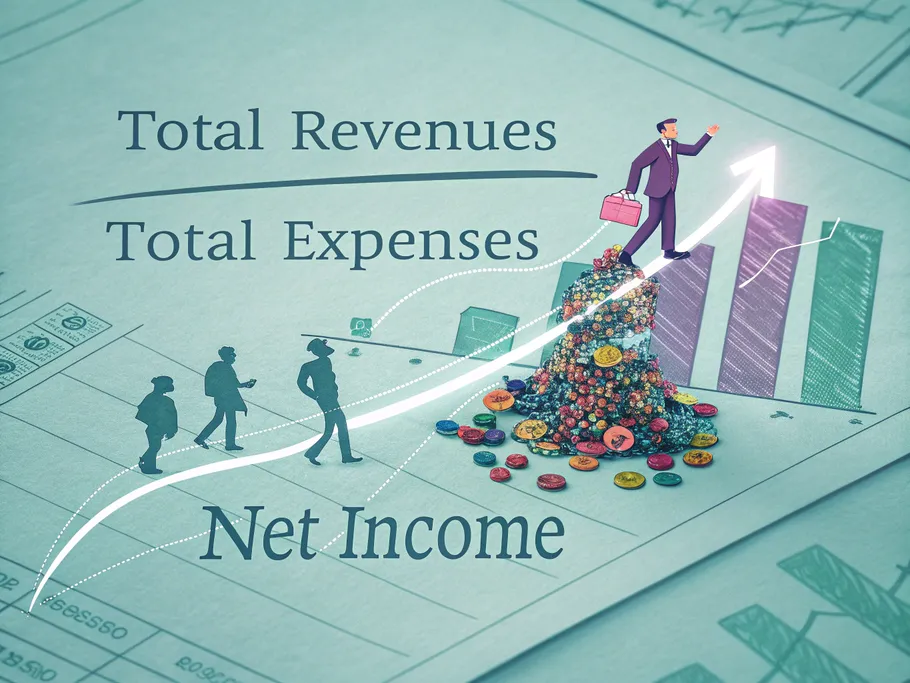Meet Alex, a founder knee-deep in the beautiful chaos of a growing e-commerce business. After a grueling quarter, two documents land in their inbox from the new accountant: an “Income Statement” and a “Balance Sheet”.
Alex’s eyes dart to the bottom of the income statement. A promising number glows back: “Net Income.”
Profit. Finally.
But then, scanning the balance sheet – a dense grid of assets and liabilities – the net income figure is nowhere to be found. It’s just… gone.
Where the hell did the profit go? How can a company be profitable, yet have that number seemingly vanish on the other report? If you’ve ever felt like Alex, you’re in the right place. This guide is here to demystify the income statement vs balance sheet relationship and show you exactly where your hard-earned profit lives.

The Bottom Line: What is Net Income?
Net income is the profit a company earns after you subtract all the expenses from all the revenue. It’s the ultimate report card for your profitability over a specific period. That’s why it’s called the ‘bottom line’ – it’s literally the last line on an income statement.
Key Points:
- You might also hear it called net earnings or net profit.
- It is reported on the income statement, not the balance sheet.
Calculating Your Profitability: The Net Income Formula
The math is refreshingly simple:
Total Revenues – Total Expenses = Net Income
- Revenues are all the money you earned from sales.
- Expenses are all the costs you racked up to make that revenue, like:
- Cost of Goods Sold (COGS)
- Operating expenses (rent, salaries, marketing)
- Interest
- Taxes
When Profit Turns Negative: Understanding a Net Loss
Sometimes, the formula gives you a negative number. This happens when your total expenses are greater than your total revenues, resulting in a net loss on the income statement. It’s not the end of the world, but it’s a clear signal that the business hit some financial turbulence during that period.
Your Two Most Important Financial Reports
So you have these two documents. What’s the difference? Think of it like this: your income statement is screaming, “Look how much money we made!” while your balance sheet quietly whispers, “Yeah, but here’s a snapshot of everything we own and owe.”
The Income Statement: Your Business’s Performance Story
The income statement (also known as the Profit & Loss or P&L) tells a story over a specific period – a month, a quarter, a year. It’s the movie of your financial performance, showing all the ups and downs of revenues and expenses to arrive at that final scene: net income or net loss.
The Balance Sheet: A Financial Snapshot in Time
The balance sheet isn’t a story; it’s a photograph. It captures your company’s financial position on a single day, showing what you own (assets), what you owe (liabilities), and what the owners have invested (shareholders’ equity). It always follows one simple, unbreakable rule:
Assets = Liabilities + Shareholders’ Equity
The Big Question: Where to Find Net Income on Financial Statements?
The answer is simple: Net income is reported on the income statement.
It is not a line item on the balance sheet. But – and this is the crucial part – its effects are absolutely reflected there.
From Income Statement to Balance Sheet: The Critical Link
This is where the magic of double-entry accounting comes in. The net income (or loss) from your income statement doesn’t just disappear. It flows directly into the balance sheet and gives the shareholders’ equity section a little nudge.
Specifically, net income increases an account called Retained Earnings. This account represents all the cumulative profits that have been reinvested back into the business instead of being paid out to owners as dividends. A net loss, naturally, decreases retained earnings.
- Increased revenues/gains → increased shareholder equity
- Increased expenses/losses → decreased shareholder equity
Here’s a simple analogy: The income statement is a video of your season’s performance, and net income is the final score. That score is then added to your team’s all-time record – the equity on your balance sheet snapshot.
When the Bottom Line is Red: A Deeper Look at Net Loss
It can be unsettling to see the numbers not adding up and to face the reality of a bottom line that’s in the red. But a loss isn’t a death sentence; it’s a signal.
Taking the time to understand the pieces – where revenue is low or expenses are high – is a significant first step. This quiet understanding can bring clarity, helping you see the path forward, even if it feels challenging right now.

Key Drivers of a Net Loss
- Low Revenue Stream: Sales might be down due to new competition, wonky pricing, or marketing that just isn’t hitting the mark.
- High Cost of Goods Sold (COGS): The cost to produce or acquire your products is eating up all the revenue you’re generating.
- Excessive Expenses: Your sales are fine and COGS are under control, but high operating costs (think rent, salaries, that ping-pong table) are sinking the ship.
Gross Loss vs. Net Loss: What’s the Difference?
This is a key distinction in the net income vs net loss conversation. A gross loss happens when your Cost of Goods Sold is higher than your revenue (Revenue – COGS < 0). This is a major red flag because it means you’re losing money on your core product or service before you even pay for rent or salaries.
A net loss, on the other hand, accounts for all expenses. You can absolutely have a gross profit (meaning your products are profitable on their own) but still suffer a net loss if your operating costs are out of control.
A Practical Example: Seeing a Net Loss in Action
Consider a company with these numbers:
- Sales: $200,000
- COGS: $140,000
- Other Operating Expenses: $80,000
Let’s do the math:
- Gross Profit: $200,000 (Sales) – $140,000 (COGS) = $60,000
- Net Loss: $60,000 (Gross Profit) – $80,000 (Expenses) = -$20,000
See? The company made money on its products but still ended up with a net loss because its operational costs were too high.
Advanced Concepts: Accounting for Losses
Not all losses are created equal. Here’s a quick look at how different types are handled.
Realized vs. Unrealized Losses: Where Do They Go?
- Realized losses happen when you actually sell an asset for less than you paid for it. Because this is a completed transaction that affects your cash, it gets reported on the income statement.
- Unrealized losses are paper losses. They happen when an asset you still hold (like stock) drops in value. Since you haven’t sold it yet, the loss isn’t “real.” It appears on the balance sheet as a downward adjustment to the asset’s value and a corresponding hit to shareholders’ equity.
The Mechanics: A Glimpse at Journal Entries
Losses are formally recorded using journal entries to keep the double-entry accounting system in balance.
- Loss on Sale of an Asset: This occurs when an asset is sold for less than its carrying value. The journal entry involves debiting the loss on sale of assets account, debiting accumulated depreciation, and crediting the asset account.
- Loss on Investment: This occurs when an investment is sold for less than its book value. The journal entry involves debiting the loss on investment account, debiting the cash account, and crediting the investment account.
These entries ensure the loss hits the income statement for that period, which then flows through to the balance sheet.

Key Takeaways for Business Leaders
- The Story and the Snapshot: The income statement tells your profitability story over time; the balance sheet shows your cumulative financial health at a single moment.
- Profit is King: Net income is your ultimate measure of profitability. Understanding what drives it – revenue, COGS, and expenses – is critical for making smart decisions.
- A Loss is a Signal, Not a Failure: A net loss is a sign to dig in and analyze your revenue, costs, and expenses. It’s an opportunity to find problems and fix them.
- Financial Fluency is Power: Getting comfortable with how these statements connect is essential for managing cash flow, planning for growth, and talking confidently with investors and lenders.
